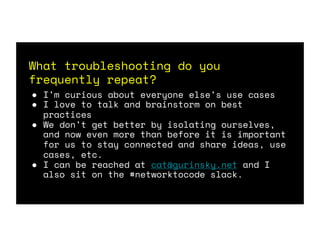Simplified Troubleshooting through API Scripting
- 1. Your logo here Simplified Network Troubleshooting through API Scripting Cat Gurinsky Senior Network Engineer
- 2. Does repeating troubleshooting by hand drive you crazy?
- 3. What we’ll cover ● Why automate our troubleshooting? ● Why API and not screen scraping? ● Examples of typical, repeatable, troubleshooting ● Example outputs of grabbing the data via API ● What skills do I need? Who has API’s? ● Examples of some actual code ● Q&A
- 4. Why Automate? ● “Your network is a crime scene, and you are the detective. You need better ways to investigate what happened, and prove guilt or innocence.” -Jeremy Schulman ● Most failures have repeatable troubleshooting steps to root cause. ● Repeatable means we can automate and code against these expectations to find our culprit. ● Why waste time typing out the same sets of commands every time you have a similar failure?
- 5. Why API versus SSH/screen scraping? ● API calls are significantly faster ○ A former colleague and I decided to both try our hands at writing a script to install an extension for a security hotfix we needed to install. ○ The colleague wrote theirs with netmiko/ssh calls, mine was with pyeapi. ○ My script consistently ran about 3-5 times faster than the colleagues did. We used mine to update the entire fleet. ● Most API’s return all the data to you in JSON so doing meaningful follow up is much easier as you don’t have to reformat a screen scrape
- 6. Typical Troubleshooting Examples ● Link down / Errors on a link ● Switch rebooted unexpectedly ● Power supply failure alert ● Dump show tech and other common outputs ● Many more possible!
- 7. Link Down / Link Errors ● Determine both sides of the bad link, if not already known ● Validate light levels for both sides to see if there is an obvious failure in Tx versus Rx ● Validate rate of bouncing if applicable, and if seen by both sides or not. ● Grab data on optics and serial numbers in case a replacement is warranted
- 8. Get relevant show commands quickly ● In case we need to swap a part or open a TAC, grabbing the inventory is a useful first step so we don’t have to worry about this later
- 9. Check for common outputs ● These are 3 common outputs I look at every time I’m checking a bad link. ● In this example for Arista’s pyeapi, the first two return JSON, the last returns text. So I parse the JSON outputs into a nice table, and return the original plain text for the last.
- 10. Rinse, Lather, Repeat! ● In the case of bad links, I want to validate the other side, so I use LLDP or descriptions / inventory database if down, to see what the far end is and run the same command sets there.
- 11. Switch rebooted unexpectedly ● When a switch reboots there are 2 things I always check ● Current uptime and code version of the switch (show version) ● What the switch thinks the reload reason was (show reload cause) ● Sure it doesn’t take long to login and do this, but it’s just super fast with API instead!
- 12. Example reload cause script output ● Simple and to the point, with relevant data in case a TAC needs to be opened for follow up. ● Also if debug information was returned, we write it to a file on the local computer so it’s ready to go.
- 13. Example FPGA error script output ● Sometimes switches require a reboot due to an uncorrectable FPGA error, quick script to validate the error is still there
- 14. Power Supply Failure ● Show inventory and grab the power supply section ● Show version in case TAC needed ● Show environment power details
- 15. Dump show tech & other common requested data for TAC ● You may find that TAC regularly asks you for the same set of files ● Most of these commands (at least in Arista world) return plain text , you may need to strip the “n”’s for the newlines when generating to a proper text file ● Use “command | json” on Arista to see if you need to request plain text or regular API json results.
- 16. How can I do this?
- 17. What skills do I need to do this? ● For my examples, a working knowledge of python and some time with your vendors API module to understand anything special about their commands. ● Most vendors have API’s and some have python modules to make your interactions even easier. ● My examples are Arista, other platforms have similar options (see last slides for useful links) Vendor Python Module Arista pyeapi Juniper py-junos-eznc Cisco No official (off box) one but plenty of user created ones Extreme exsh (on CLI) / exshexpect (wrapper for use with pexpect)
- 18. Example code (pyeapi) ● Plan to re-use switch API bits in multiple scripts? ○ Consider using a shared library file + class ● Create your “node” aka switch device w/ pyeapi ● Timeout is optional ○ For slow commands (like show tech) add this to reduce timeout errors in the scripts
- 19. Show inventory examples (pyeapi) ● Once you get used to the json formatting, finding the data you want is very quick. ● On Arista, from CLI of the switch, you can see what the JSON format for the data looks like by typing command | json ● Example extracting inventory from sub- sections of the output
- 20. Show version example (pyeapi) ● Show commands come back with json formatting, so manipulating them is very simple ● In this example we get show version details and then manipulate them into a new dictionary that is easier to use in our scripts
- 21. Current uptime example (pyeapi) ● Once we have values, like time of a last reload, it’s easy to use normal python to manipulate that and get values like uptime in days.
- 22. Other use cases for API scripting ● We don’t have to limit ourselves to API scripting for troubleshooting efficiency! ● Tedious Tasks: ○ Update port descriptions based on LLDP, ARP and IPv6 Neighbor data (remove human error, and validate patch plans) ○ Pre-upgrade flight checks (LACP on MLAG’s, lots of show commands)
- 23. Other use cases for API scripting ● Remediation: ○ Installing extensions, including Security Hot Fixes with validation of if they are already on the box or not ○ Pushing baseline and ACL config remediations ● The possibilities are only limited by your creativity!
- 24. No API? There’s always SNMP… ● Not all devices have API available ● Next best option is probably SNMP polling (at least for errors, discards, link state) ● For links you’ll have to map out the OID’s for your ifDescr -> Errors/Discards/Bits etc ● Once logic has been written, SNMP is still a faster way to get this data compared to SSH screen scraping
- 25. Optimization ● Try to run your tools scripts locally to the site for the best return times on API, SNMP and other calls ● Cache data when possible to speed up script runs even more (interface names for example) ○ Some companies have Network Source of Truth (NSoT) databases with interfaces stored, query this first before polling the device for actual counters and state based information ● Create outputs formatted in the way best suited for your ticketing systems and tools ○ Example: in one ticket system I use, I can add the following output around my outputs to keep it pre-formatted as a code block: ○ [code]<pre> < /pre>[/code]
- 26. Security Best Practices ● Don’t save API/SSH passwords or SNMP communities hard coded in your scripts ● Prompt with getpass or store in environment variables ● Try not to write “current employer” specific code ● Plan ahead for multi-vendor environments
- 27. What troubleshooting do you frequently repeat? ● I’m curious about everyone else’s use cases ● I love to talk and brainstorm on best practices ● We don’t get better by isolating ourselves, and now even more than before it is important for us to stay connected and share ideas, use cases, etc. ● I can be reached at [email protected] and I also sit on the #networktocode slack.
- 28. Questions?
- 29. Useful Links to Get Started ● Junos ○ https://www.juniper.net/documentation/en_US/junos/inform ation-products/pathway-pages/rest-api/rest-api.html ● Arista EOS ○ https://eos.arista.com/arista-eapi-101/ ○ https://www.arista.com/en/support/hands-on-training ● NX-OS ○ https://www.cisco.com/c/en/us/td/docs/switches/datacente r/nexus3000/sw/python/api/python_api/getting_started.htm l ○ https://developer.cisco.com/docs/nx-os/#cisco-nexus- 9000-series-python-sdk-user-guide-and-api-reference
- 30. Useful Links to Get Started ● Extreme ○ https://documentation.extremenetworks.c om/pdfs/exos/Python_Getting_Started_Gui de.pdf?_ga=2.130088522.477422756.153901 5445-1617289114.1533937563
- 31. Useful links continued ● Cisco + Python examples: ○ https://developer.cisco.com/codeexchange/github /repo/CiscoDevNet/python_code_samples_network/ ● Module docs ○ https://junos-pyez.readthedocs.io/en/2.6.3/ ○ https://pypi.org/project/junos-eznc/ ○ https://pyeapi.readthedocs.io/en/latest/ ○ https://pypi.org/project/pyeapi/ ○ https://github.com/arista-eosplus/pyeapi



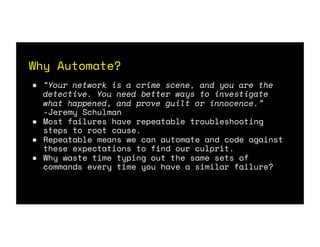




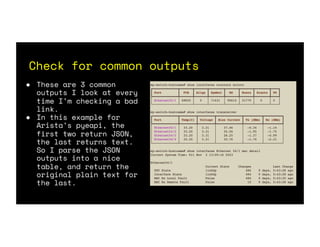
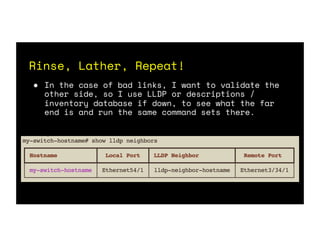
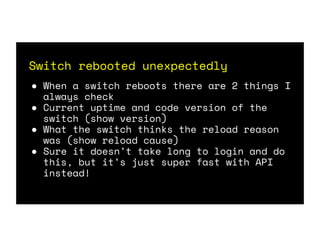


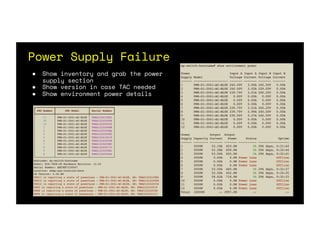
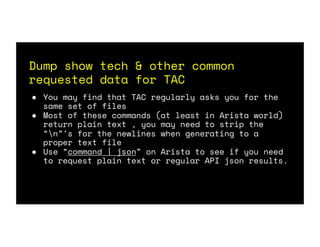



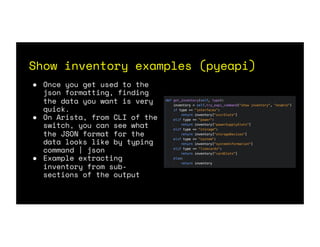
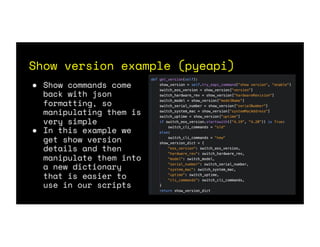

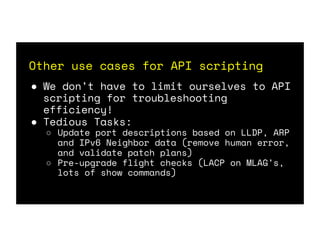
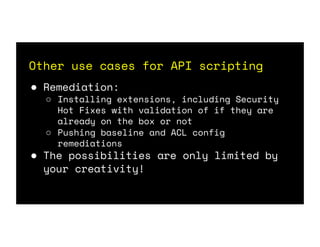
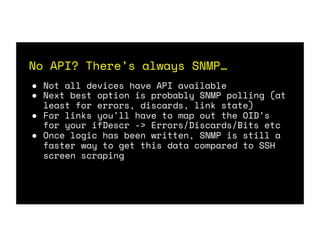
![Optimization
● Try to run your tools scripts locally to the site for
the best return times on API, SNMP and other calls
● Cache data when possible to speed up script runs even
more (interface names for example)
○ Some companies have Network Source of Truth (NSoT) databases
with interfaces stored, query this first before polling the
device for actual counters and state based information
● Create outputs formatted in the way best suited for your
ticketing systems and tools
○ Example: in one ticket system I use, I can add the following
output around my outputs to keep it pre-formatted as a code
block:
○ [code]<pre> < /pre>[/code]](https://image.slidesharecdn.com/uiwatyisfyp6gpsgutcf-ac0-day2-talk3-catgurinsky-231129171910-dbd500d0/85/Simplified-Troubleshooting-through-API-Scripting-25-320.jpg)

